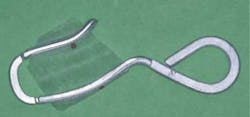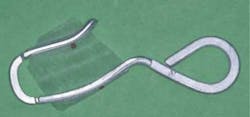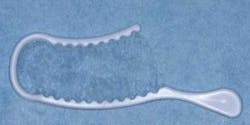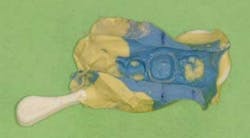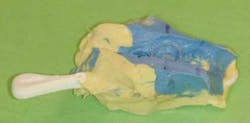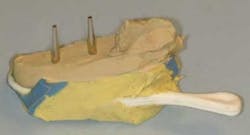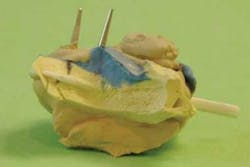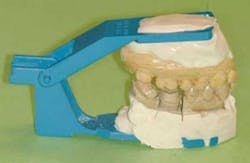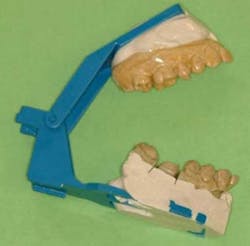Ask Dr. Christensen: Are double-arch impressions equal to full-arch impressions?
It is estimated that simple fixed prosthodontic procedures, primarily single crown restorations, comprise about 80% of the fixed prosthodontic procedures accomplished in current restorative dentistry. Most dental schools teach the full-arch maxillary and mandibular impression concept for single crowns, in spite of its being more difficult and more work. Why? The concept includes an impression for the arch with the tooth preparation, another impression for the opposing arch, and a bite registration. I understand the decision well because it teaches the neophyte dentist proper occlusion and dental anatomy. When using this concept, the entire dentition can be observed, which allows easy duplication of dental anatomy and occlusion. The contours of the teeth on the opposing side of the mouth can be observed and duplicated in mirror image form, and the canine rise and incisal guidance can be observed and duplicated quite well. However, the time involved and the cost for the full-arch orientation is significantly more than for the double-arch concept.
The Clinicians Choice Anterior Quad-Tray is a well-designed rigid tray that meets the optimum requirements for a double-arch tray for one or two tooth units.
The Premier "Sideless Triple Tray" is a well designed flexible tray that meets the optimum requirements for a double-arch tray for one or two tooth units.
Your question infers that your laboratory technician feels the full-arch concept is better. Is it better? In answer, the scientific research on the subject can be an initial guide. The references available upon request show that the fit and overall adequacy of crowns made by the double-arch concept are as good or better than those made by the full-arch concept. My personal experiences and observations as a long-time prosthodontist certainly solidly confirm that conclusion.
However, there is another side to this story. From my discussions with dental laboratory technicians, I understand that many double-arch impressions are not made adequately, and that some laboratory technicians have difficulty making acceptable crowns using them. There are many reasons for these inadequate impressions. Rather than enumerating the inadequacies, I will discuss and illustrate how to make an adequate double-arch impression. By following the points listed below, you should be able to provide your technician with highly acceptable impressions.
Selection of an adequate double-arch tray
There are numerous double-arch trays available. In my opinion, the majority have questionable designs. This may be why some technicians have difficulty with the double-arch impression technique. What is a good double-arch impression tray design? The characteristics necessary for a good double-arch tray are listed below. The trays shown in Figs. 1 and 2 satisfy these characteristic requirements for optimum success. They have been thoroughly investigated and found to be acceptable by our research group, CLINICIANS REPORT. Please observe those trays as you read the next part of this article.
- The double-arch impression tray may be rigid or flexible. Some dentists prefer to use rigid metal trays for double-arch impressions. If using a rigid tray (Fig. 1), medium or light viscosity impression material may be used for the impression. I prefer medium viscosity material, either vinyl polysiloxane or polyether, because it can be blown around the prepared tooth (teeth) to break the surface tension and reduce bubbles prior to placing the impression material in the tray into the mouth. Light viscosity impression material often blows off the tooth preparations using the technique suggested above. The rigid tray provides significant support for the impression. If using a flexible tray (Fig. 2), I prefer to use a medium viscosity impression material to "blow" around the prepared tooth (teeth) with a light air stream before using a heavy viscosity material as the tray material.
- Sideless. The sides on the tray should not extend significantly into the vestibule. A simple thin piece of metal or plastic is desirable as the supporting side arms. If the sides extend into the palatal area or into the floor of the mouth, the tray is often deflected when the patient bites into maximum intercuspation, and the bony contours of the mouth distort the tray arms. Subsequently, when the tray is removed from the mouth, the stressed sides of the tray can deflect the impression material back into a non-stressed form, thus distorting the overall impression.
- Thin connecting arm on the distal of the tray. The distal arm connecting the two sides must be very thin. If the arm is too thick, the upper and lower jaw cannot close properly because the maxillary tuberosity and the mandibular retromolar pad are restricted by the connector and will not allow optimum closure. The result is a deviation in the arc of closure or a lack of complete closure.
- Thin wafer between the arches. A thick interocclusal wafer does not allow the teeth on the opposing arches to come together accurately. The distortion often makes the restoration too high. Some double-arch trays actually have relatively thick plastic mesh as an interocclusal material. The thinner the interocclusal material, the more adequate the closure into the correct maximum interocclusal position.
- Nonabsorbent interocclusal wafer. Most impressions must be transported or mailed to a remote dental laboratory, and in most cases this requires one or two days of delay before pouring the casts. If the interocclusal wafer has absorbed moisture while in the mouth, the moisture evaporates before the technician pours the casts. The result is distortion of the occlusal relationship and likely a restoration that is too high or too low.
The optimum characteristics of an adequate double-arch impression
- Ensure correct contact of the teeth on the side of the mouth not being treated. I suggest before making the double-arch impression that you carefully observe the occlusion of the teeth on the opposite side of the mouth, mentally remembering the tooth contacts. When the tray is inserted into the mouth, observe the occlusal contacts of the teeth on the opposite side of the mouth from the side being treated to confirm that the same occlusal contacts are being made. After initial insertion of the impression into the mouth and patient closure, a good way to ensure closure is to caution the patient that you are going to tap him or her on the chin, and then do so, thereby encouraging the mandible into maximum intercuspation.
- The plastic or metal of the tray should not touch the teeth. If the tray touches the teeth, the tray is deflected away from the teeth. Upon removal of the impression, the elastic nature of the impression material often allows the tray to spring back into its original unstressed tray position, thus distorting the impression. The tray can touch the soft tissue without any significant challenges or distortion, since the soft tissue is resilient and does not cause the tray to deflect. If the tray touches the teeth, remake the impression.
- The canines should be included in the impression. The upper and lower canines on the side of the arch being treated should be present in total. Their presence allows the technician to slide the casts together to simulate canine rise, despite the fact that the canines on the opposite side of the arch are not present in the cast. You should place enough impression material in the tray to include not only the canine, but also the lateral incisors and sometimes the central incisors on the side being treated. This provides more occlusion information for the laboratory technician.
The simply mounted casts are ready for crown fabrication.
To answer your question, in my opinion, based on both scientific evidence and clinical observation, the double-arch impression concept is not only as good as a full-arch concept for one or two units, it is better!
If you make an impression in the manner just described, you may rest assured that it will provide a highly acceptable representation of the prepared tooth (teeth), the surrounding teeth, and the interocclusal relationship. It has been my experience over thousands of crowns, and very infrequently must I alter any characteristic of crowns before cementation.
We have two educational DVDs related to this subject: V1931 - "Predictable Fixed & Removable Prosthodontic Impressions" and V4745 - "Dental Assisting for Posterior Tooth Restorations." Contact Practical Clinical Courses at (800) 223-6569 or visit our Web site at www.pccdental.com for further information.
References available upon request.
About the Author

Gordon J. Christensen, DDS, PhD, MSD
Gordon J. Christensen, DDS, PhD, MSD, is founder and CEO of Practical Clinical Courses and cofounder of Clinicians Report. His wife, Rella Christensen, PhD, is the cofounder. PCC is an international dental continuing education organization founded in 1981. Dr. Christensen is a practicing prosthodontist in Provo, Utah.
